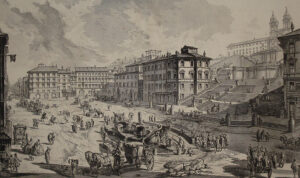Rechts aan de voet van de Spaanse Trappen in Rome staat een huis. Het ontleent zijn naam aan de dichter die er stierf. John Keats (1795-1821) betrok zijn kamers in de tweede helft van november 1820 en stierf er op de avond van 23 februari 1821. Overlijden op een van de mooiste plekken in Rome droeg bij aan de onsterfelijkheid van zijn roem. Het Keats-Shelly House werd een geliefd museum. Het werd opengesteld in 1909 en doorstond zonder schade de periode tussen de eerste en de tweede wereldoorlog. In 1942 groeide de dreiging en was het nodig het huis te sluiten. Met de komst van de Amerikanen gingen de deuren van het Keats-Shelly House in Rome weer open.
Over het Huis doen veel verhalen de ronde. In zijn boek A Traveller in Rome vertelt de Engelse schrijver H. V. Morton een aardige anecdote over de oorlogsjaren. Hij tekende het verhaal op uit de mond van de persoon aan wie de zorg voor het Huis was toevertrouwd.
De anecdote van Morton
I was surprised to be told by the loyal curator, Signora Signorelli Cacciatore, for this house seems to inspire devotion, that while hundreds visited the Keats House before the last war, thousands now come. She told me the story of the adventures of the Keats House during the war, which is an exciting one. The moment she realized that Italy was to be dragged into the war on Germany’s side, she packed up the chief treasures in two boxes and to the Monastery of Monte Cassino, where the archivist, Don Mauro Inguanez, concealed them in his cell.
When the Allies landed in Italy, the Germans ordered the monks to leave, and many of their treasures fell into the eager hands of the Hermann Goering division. The Keats relics would also have done so had Don Mauro not sent them back to Rome as his own luggage. To the astonishment of the curator, they arrived one night in a German lorry and with an armed guard provided by the looters themselves.
June 1944
An anxious time followed. Germans who tried to enter the house were told that it was shut up and empty. On June 4, 1944, the Germans left Rome by one gate as the Allies entered by another. The Signora stood at the window and watched this happening. It was a calm moonlit night. The last Germans had gone; the last bursts of machine gun fire were over. Unearthly was the silenceas even the usual sound of was stilled, for the conduits had been bombed and, like all the fountains of Rome, it was dry.
Suddenly a voice was heard calling from one of the windows in the Piazza di Spagna that the Allies were coming! She heard the rumble of approaching tanks. Then two files of armed figures passed silently in the moonlight. People ventured out of their houses and some flashed torches in the faces of the soldiers, who smiled and passed on into the darkness. Then an order was given and a halt was made. The Piazza was crowded. There in the moonlight the soldiers slept: on the pavements, in the dried-up fountain, on the Spanish Steps. For a moment it seemed to Signora Cacciatore that all these men were dead, victims of a silent battle fought in the Piazza.
‘On the next day, at six o’clock in the morning,’ said the Signora, ’the first Allied visitor knocked on the door. It was a Mr A. C. Sedgwick, the New York Times correspondent with the American Fifth Army, and with him was Captain Morgan, a British Public Relations Officer. “Everything all right?” asked Mr Sedgwick. In proof that it was, the windows were opened for the first time in four years.’

Aantekeningen bij het Keats-Shelly House in Rome
- Het zicht op de Spaanse Trappen is van Piranesi. Hij maakte de ets rond 1750.
- H. V. Morton, A Traveller in Rome. London: Methuen & Co, 1957, pp. 244-245.
- De correspondent voor de New York Times A. C. Sedgwick (1902-1996) was in 1924 afgestudeerd in Engelse literatuur aan de Harvard University. Het lag dus voor de hand dat deze geletterde Amerikaan profiteerde van ziijn aanwezigheid op Piazza di Spagna.
- Zie hier de website van het Huis.
